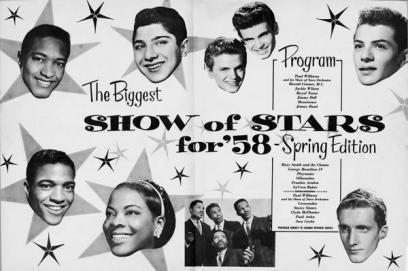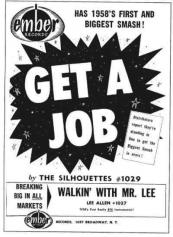
The Silhouettes (Philadelphia)
Personnel :
Bill Horton (Lead)
Earl Beal (Baritone)
Richard "Rick" Lewis (Tenor)
Raymond Edwards (Bass)
Discography :
1957 - Get A Job / I Am Lonely (Junior 391/Ember 1029)
1958 - Headin' For The Poorhouse / Miss Thing (Ember 1032)
1958 - Bing Bong / Voodoo Eyes (Ember 1037)
1958 - I Sold My Heart To The Junkman / What Would You Do (Junior 396/Ace 552)
1959 - Evelyn / Never Will Part (Junior 400/Ace 563)
1960 - Never / Bull Frog (20th Fox 240)
1962 - Wish I Could Be There / Move On Over (To Another Land) (Grand 142)
1962 - The Push / Which Way Did She Go (Imperial 5899)
1963 - Rent Man / Your Love (Is All I Need) (Junior 993)
1967 - Climb Every Mountain / We Belong Together (Jamie 1333)
1968 - Not Me Baby / Gaucho Serenade (Goodway 101)
Biography :
Formed
in 1956 in Philadelphia, Pennsylvania, USA, the Silhouettes recorded
one of the classics of the doo-wop era, "Get A Job". The song was
written by tenor Rick Lewis (b. 23 September 1933) while he was in the
US Army, stationed in Germany.

Upon returning home, Lewis joined a singing group called the Parakeets. He left them to front a band called the Gospel Tornadoes, comprising lead singer Bill Horton (b. 25 December 1929, d. 23 December 1995), bass singer Raymond Edwards (b. 22 September 1922) and baritone Earl Beal (b. 18 July 1924). When the gospel group changed to secular music, it took on a new name, the Thunderbirds. A disc jockey, Kae Williams, signed the group to his own Junior Records in 1958 and "Get A Job" was recorded as the b-side to the ballad "I Am Lonely".


The
group's name was changed to the Silhouettes (after a 1957 hit by the
Rays) and the record was released on the larger Herald-Ember label. "Get
A Job" received more attention than the ballad side and ultimately
found its way to number 1 in the USA, becoming, in time, one of the
best-known up-tempo doo-wop records. The nonsense phrase "sha-na-na-na",
part of its lyric, was borrowed in the late 60s by the rock 'n' roll
revival group Sha Na Na. 1958 the Silhouettes recorded a number of follow-ups, Bing Bong for
example, but never again returned to the charts. With numerous personnel
changes, the group managed to stay afloat until 1968, latterly as the
New Silhouettes. The four original members reunited in 1980 and carried on working the revival circuit until Horton's death in 1995.
Video :
Get A Job
